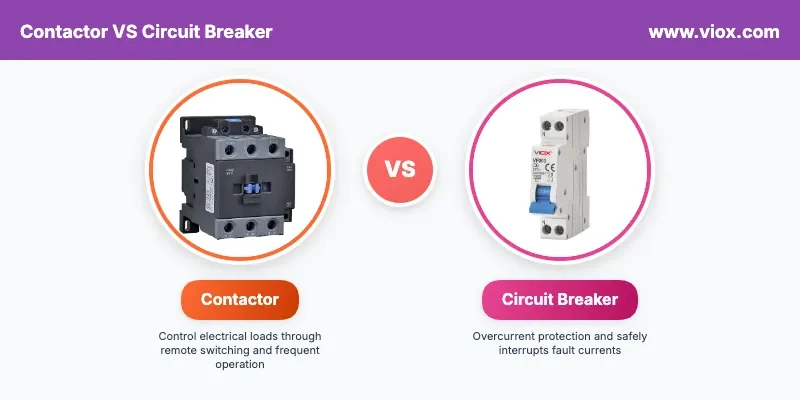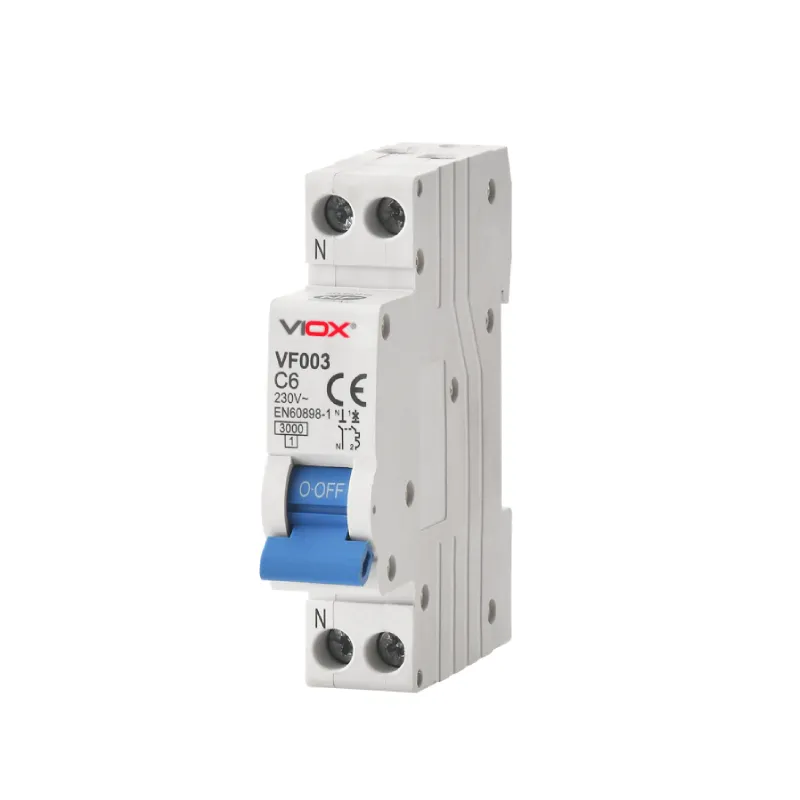What Is a Contactor? Essential Definition and Function
A مقاول is an electrically controlled switching device designed to make and break electrical circuits under normal load conditions. Think of it as a remote-controlled heavy-duty switch that can handle high currents and voltages safely.
Key Contactor Characteristics:
- Electromagnetically operated switching mechanism
- Designed for frequent switching operations (thousands to millions of cycles)
- Controlled by low-voltage signals (typically 24V, 120V, or 240V coils)
- Can switch resistive, inductive, and capacitive loads
- Available in AC and DC configurations
💡 نصيحة الخبراء: Contactors are rated for specific electrical life cycles – a 3-pole contactor might be rated for 10 million mechanical operations but only 1 million electrical operations at full load.
What Is a Circuit Breaker? Protection Device Fundamentals
A قاطع الدائرة الكهربائية is an automatic electrical switching device designed to protect electrical circuits from damage caused by excess current from overload or short circuit conditions. Unlike contactors, circuit breakers prioritize protection over frequent switching.
Key Circuit Breaker Characteristics:
- Automatic tripping mechanism for overcurrent protection
- Manual reset capability after fault clearing
- Arc extinction technology for safe current interruption
- آليات الرحلة الحرارية والمغناطيسية
- Designed for infrequent operation under fault conditions
⚠️تحذير السلامة: Never use a circuit breaker as a regular on/off switch. Frequent manual switching can damage the internal mechanisms and compromise protection capabilities.
Contactor VS Circuit Breaker: Comprehensive Comparison Table
| الميزة | المقاول | قاطع دوائر كهربائية |
|---|---|---|
| الغرض الأساسي | Load switching and control | الحماية من التيار الزائد |
| طريقة التشغيل | Remote electrical control | Automatic fault detection + manual operation |
| تردد التحويل | High (daily/hourly operation) | Low (only during faults or maintenance) |
| الحالي التقييم | 9A to 800A+ | 15A to 6000A+ |
| تقييمات الجهد | Up to 1000V AC, 750V DC | Up to 69kV AC, 3200V DC |
| خصائص الرحلة | None (no protection function) | Thermal, magnetic, electronic |
| جهد التحكم | 24V-480V coil control | Manual operation/automatic trip |
| الحياة الكهربائية | 100,000 to 10 million operations | 10,000 to 25,000 operations |
| Arc Interruption | Limited fault current capability | High fault current interruption |
| تكلفة مجموعة | $50-$2,000+ | $25-$5,000+ |
| موقع التركيب | Control panels, motor starters | Main panels, distribution boards |
| الامتثال للمعايير | IEC 60947-4, NEMA AB1 | IEC 60898, UL 489, NEMA AB4 |
Key Differences: When to Use Each Device
Contactor Applications and Use Cases
Motor Control Systems:
- Starting and stopping electric motors
- Reversing motor direction
- Speed control in conjunction with variable frequency drives
- Emergency motor stopping (when combined with overload relays)
التحكم في الإضاءة:
- Large-scale lighting systems in commercial buildings
- Street lighting control
- Stadium and arena lighting switching
- Exterior building illumination control
أنظمة التدفئة والتهوية وتكييف الهواء:
- Compressor control in air conditioning systems
- Fan motor switching
- Electric heating element control
- Pump control for hydronic systems
التطبيقات الصناعية:
- Welding equipment switching
- Electric furnace control
- Conveyor system motor control
- Crane and hoist operations
💡 نصيحة الخبراء: Choose contactors based on the AC1 rating for resistive loads (lighting, heating) or AC3 rating for motor loads. AC3 ratings are typically 50-60% of AC1 ratings due to inductive load switching requirements.
Circuit Breaker Applications and Use Cases
Electrical Panel Protection:
- Main service entrance protection
- Branch circuit protection in distribution panels
- Feeder circuit protection for sub-panels
- Equipment disconnect and protection
حماية المحرك:
- Motor circuit protection (when sized 125% of motor FLA)
- Backup protection for motor starters
- Single motor disconnect and protection
- Motor control center (MCC) protection
Fault Current Protection:
- Short circuit protection for electrical systems
- Ground fault protection (with GFCI breakers)
- Arc fault protection (with AFCI breakers)
- Equipment protection from overcurrent conditions
Specialty Applications:
- DC circuit protection in solar systems
- Generator output protection
- UPS system protection
- Battery bank protection
Selection Criteria: How to Choose the Right Device
Contactor Selection Guidelines
1. Load Type Classification:
- AC1 (Resistive): Heating elements, lighting, non-inductive loads
- AC3 (Motor): Standard squirrel cage motors, normal starting
- AC4 (Motor): Frequent starting, plugging, jogging applications
2. Electrical Ratings:
- Continuous current rating must exceed load current by 25%
- Voltage rating must match or exceed system voltage
- Control coil voltage should match available control power
3. Environmental Considerations:
- Operating temperature range (-25°C to +70°C typical)
- Humidity and corrosion resistance requirements
- Shock and vibration resistance for mobile applications
4. Auxiliary Contact Requirements:
- Number of normally open (NO) and normally closed (NC) contacts
- Auxiliary contact ratings for control circuits
- Interlock requirements for safety systems
Circuit Breaker Selection Guidelines
1. Protection Requirements:
- Continuous current rating based on conductor ampacity
- Interrupting capacity must exceed available fault current
- Trip characteristics (thermal, magnetic, electronic)
2. Application Standards:
- Branch circuits: 15A, 20A, 30A for general purpose
- دوائر المحرك: 125% of motor full load amperage minimum
- Feeder circuits: Based on load calculation and conductor sizing
3. Special Protection Features:
- Ground fault protection for personnel safety
- Arc fault protection for fire prevention
- Adjustable trip settings for coordination
4. Physical Requirements:
- Panel space and mounting considerations
- Wire termination methods and sizes
- Accessibility for operation and maintenance
Installation and Wiring: Professional Best Practices
Contactor Installation Requirements
Mounting and Location:
- Install in properly rated enclosures (نيما 1, 3R, 4, 12)
- Maintain manufacturer-specified clearances for heat dissipation
- Orient per manufacturer recommendations (usually vertical)
- Provide adequate ventilation for arc chutes
Wiring Practices:
- Use properly sized conductors based on contactor ratings
- Install overload relays for motor protection applications
- Provide control circuit isolation and protection
- Include status indication lights for operational feedback
⚠️تحذير السلامة: Always verify proper coil voltage before energizing. Wrong voltage can cause coil failure, contact welding, or fire hazards.
Circuit Breaker Installation Requirements
Panel Installation:
- Mount in listed electrical panels with proper bus connections
- Ensure proper torque on all connections per manufacturer specifications
- Verify adequate short circuit current rating for installation location
- Maintain proper spacing for heat dissipation and arc flash considerations
الامتثال للقانون:
- يتبع إن إي سي Article 240 for overcurrent protection requirements
- Comply with local electrical codes and amendments
- Obtain proper permits and inspections for installations
- Maintain required working spaces per NEC 110.26
اعتبارات السلامة والتوصيات المهنية
Critical Safety Practices
Electrical Safety:
- Always de-energize circuits before installation or maintenance
- Use lockout/tagout procedures for multi-person work
- Verify absence of voltage with rated test equipment
- Wear appropriate PPE including arc flash protection
System Safety:
- Ensure proper grounding and bonding of all components
- Provide appropriate fault current protection
- Install emergency stop capabilities where required
- Maintain proper coordination between protective devices
⚠️تحذير السلامة: Contactors and circuit breakers contain high-energy components. Only qualified electrical personnel should install, maintain, or troubleshoot these devices.
متى تتصل بمتخصص
Situations Requiring Professional Electricians:
- Service entrance and main panel modifications
- Motor control center installations
- High-voltage applications (over 1000V)
- Arc flash hazard assessments
- Complex control system design
متطلبات الشهادة:
- Licensed electricians for permanent installations
- Factory training for specialized equipment
- Safety certifications for high-voltage work
- Continuing education for code updates
استكشاف المشكلات الشائعة وإصلاحها
مشاكل وحلول المقاولين
| المشكلة | الأسباب المحتملة | حلول |
|---|---|---|
| Contactor won’t close | Failed coil, control power loss, mechanical binding | Check coil voltage, inspect contacts, verify control circuit |
| Contacts welding together | Overcurrent, voltage transients, worn contacts | Install proper protection, check load current, replace contacts |
| Excessive noise | Worn magnetic surfaces, voltage variations | Clean magnetic surfaces, stabilize voltage, replace if severe |
| Short electrical life | Improper application, oversized load, frequent switching | Verify ratings, check load characteristics, consider derating |
Circuit Breaker Problems and Solutions
| المشكلة | الأسباب المحتملة | حلول |
|---|---|---|
| التعثر المزعج | Overload, loose connections, wrong breaker type | Check load current, tighten connections, verify application |
| Won’t trip during fault | Failed mechanism, improper calibration | Test trip function, professional inspection required |
| Won’t reset after trip | Persistent fault, mechanical damage | Clear fault condition, inspect for damage, replace if needed |
| وميض القوس أثناء التشغيل | Improper interrupting rating, system fault | Stop use immediately, professional assessment required |
Quick Reference Guide: Selection Checklist
Contactor Selection Checklist
- [ ] Determine load type (AC1, AC3, AC4)
- [ ] Calculate required current rating (125% of load minimum)
- [ ] Verify voltage ratings (line and coil)
- [ ] Specify auxiliary contact requirements
- [ ] Consider environmental conditions
- [ ] Check mechanical and electrical life requirements
- [ ] Verify compliance with applicable standards
Circuit Breaker Selection Checklist
- [ ] Calculate continuous current requirements
- [ ] Determine interrupting capacity needs
- [ ] Select appropriate trip characteristics
- [ ] Consider special protection features (GFCI, AFCI)
- [ ] Verify panel compatibility and space
- [ ] Check applicable code requirements
- [ ] Consider coordination with other protective devices
الأسئلة المتداولة
Can I use a circuit breaker as a contactor?
No, circuit breakers are not designed for frequent switching operations. Using a circuit breaker as a regular on/off switch will cause premature failure and compromise protection capabilities. Circuit breakers are designed for infrequent operation, typically only during fault conditions or maintenance.
What happens if I use the wrong device?
Using a contactor for protection or a circuit breaker for frequent switching can lead to equipment failure, safety hazards, and code violations. Contactors lack overcurrent protection, while circuit breakers aren’t designed for frequent operation.
How do I size a contactor for motor applications?
For motor applications, use the AC3 rating and select a contactor with a current rating at least equal to the motor’s full load amperage. Consider derating for frequent starting applications or harsh environmental conditions.
What’s the difference between thermal and magnetic circuit breakers?
Thermal breakers use bimetallic strips for overload protection, while magnetic breakers use electromagnets for instantaneous short circuit protection. Most modern breakers combine both technologies for comprehensive protection.
Can contactors provide motor protection?
Contactors alone cannot provide motor protection. They must be combined with overload relays or motor protection circuit breakers to provide complete motor protection including overload, phase loss, and short circuit protection.
How often should these devices be maintained?
Contactors require more frequent maintenance due to regular operation – inspect contacts and clean arc chutes annually. Circuit breakers need less frequent maintenance but should be tested every 5-10 years depending on application and manufacturer recommendations.
What causes contact welding in contactors?
Contact welding typically results from excessive inrush current, voltage transients, or contacts nearing end of life. Proper current limiting, transient suppression, and timely contact replacement prevent welding.
Are there combination devices available?
Yes, motor circuit protectors and motor protection circuit breakers combine switching and protection functions. These devices offer both contactor switching capabilities and circuit breaker protection in a single unit.
الخاتمة: اتخاذ الخيار الصحيح لتطبيقك
Understanding the fundamental differences between contactors and circuit breakers is crucial for safe and effective electrical system design. Contactors excel at load switching and control applications, while circuit breakers provide essential overcurrent protection. The key to success lies in selecting the right device for the specific application requirements.
For motor control applications, use contactors with appropriate overload protection. For circuit protection, choose circuit breakers with proper current ratings and interrupting capacity. When in doubt, consult with qualified electrical professionals to ensure code compliance and system safety.
ذات صلة
المعايير الكهربائية للموصلات: فهم فئات استخدام AC1 و AC2 و AC3 و AC4 و DC1 و DC2 و DC3





